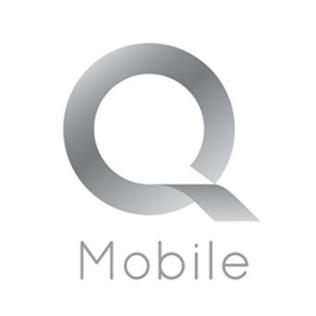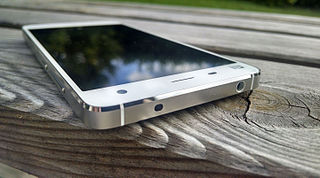
A smartphone is a mobile device that combines the functionality of a traditional mobile phone with advanced computing capabilities. It typically has a touchscreen interface, allowing users to access a wide range of applications and services, such as web browsing, email, and social media, as well as multimedia playback and streaming. Smartphones have built-in cameras, GPS navigation, and support for various communication methods, including voice calls, text messaging, and internet-based messaging apps.
Sony Mobile Communications Inc. was a multinational telecommunications company founded on October 1, 2001, as a joint venture between Sony Corporation and Ericsson. It was originally incorporated as Sony Ericsson Mobile Communications, and headquartered in London, England, until Sony acquired Ericsson's share in the venture on February 16, 2012. On April 1, 2021, Sony integrated its electronics businesses including Sony Mobile into one company called Sony Corporation.
Pantech Inc. is a South Korean company that manufactures mobile phones. Established in 1991, its market is mainly domestic with partners in the United States, Japan, China, Europe and Vietnam. In 2012 Pantech was the second best-selling handset maker in South Korea, according to Gartner. In 2013 Samsung Electronics bought a 10% stake in Pantech. Pantech also partners with PCD for specialized phones.

A tablet computer, commonly shortened to tablet, is a mobile device, typically with a mobile operating system and touchscreen display processing circuitry, and a rechargeable battery in a single, thin and flat package. Tablets, being computers, have similar capabilities, but lack some input/output (I/O) abilities that others have. Modern tablets largely resemble modern smartphones, the only differences being that tablets are relatively larger than smartphones, with screens 7 inches (18 cm) or larger, measured diagonally, and may not support access to a cellular network. Unlike laptops, tablets usually run mobile operating systems, alongside smartphones.
Alcatel is a French brand of mobile handsets owned by Finnish consumer electronics company Nokia and used under license by Chinese electronics company TCL Technology. The Alcatel brand was licensed in 2005 by former French electronics and telecommunications company Alcatel-Lucent to TCL for mobile phones and devices, and the current license expires at the end of 2024. Nokia acquired the assets of Alcatel-Lucent in 2016 and thus also inherited the licensing agreements for the Alcatel brand.
Android is a mobile operating system based on a modified version of the Linux kernel and other open-source software, designed primarily for touchscreen mobile devices such as smartphones and tablets. Android is developed by a consortium of developers known as the Open Handset Alliance, though its most widely used version is primarily developed by Google. It was unveiled in November 2007, with the first commercial Android device, the HTC Dream, being launched in September 2008.
A mobile operating system is an operating system used for smartphones, tablets, smartwatches, smartglasses, or other non-laptop personal mobile computing devices. While computers such as typical/mobile laptops are "mobile", the operating systems used on them are generally not considered mobile, as they were originally designed for desktop computers that historically did not have or need specific mobile features. This line distinguishing mobile and other forms has become blurred in recent years, due to the fact that newer devices have become smaller and more mobile unlike hardware of the past. Key notabilities blurring this line are the introduction of tablet computers, light-weight laptops, and the hybridization of the two in 2-in-1 PCs.
The form factor of a mobile phone is its size, shape, and style, as well as the layout and position of its major components.
The Samsung Behold II is a touch-screen, 3G- compatible smartphone with a 5.0-megapixel camera. The Samsung Behold II is powered by the Android OS, making it the fourth Android powered phone by T-Mobile USA. Other Android powered phones by T-Mobile are the G1, myTouch 3G, and the Motorola CLIQ. It was released on November 18, 2009. On May 27, 2010, Samsung announced that Android 1.6 "Donut" would be the final firmware release for the device.

The Samsung Galaxy 3, also known as the Samsung Galaxy Apollo, Samsung Galaxy Mini in Italy, or Samsung Galaxy 580 in Hong Kong, is a smartphone manufactured by Samsung that runs the open source Android operating system. Announced and released by Samsung in July 2010, the Galaxy 3 succeeds the Samsung Galaxy Spica.
Nokia's strategic nomenclature can be traced back in 2005 when the Nseries line was launched, offering devices with flagship specifications and premium hardware at various price points. These devices were considered the "bread and butter" of the company and were often positioned to showcase their latest technologies. Thanks to the newfound consumer and enterprise interest in smartphones at the time, the company introduced four additional collections to diversify their product portfolio and meet demands in most market segments. These new phone series were named Eseries, targeting small business and enterprise customers; Xseries, providing consumer-grade multimedia-focused devices; Cseries, which Nokia used to target both the low-end and mid-range market segments; and Tseries, for devices exclusive to the Chinese market.
A lock screen is a computer user interface element used by various operating systems. They regulate immediate access to a device by requiring the user to perform a certain action in order to receive access, such as entering a password, using a certain button combination, or performing a certain gesture using a device's touchscreen. There are various authentication methods to get past the lock screen, with the most popular and common ones being personal identification numbers (PINs), the Android pattern lock, and biometrics.

The Samsung Galaxy Young is a low-end 32-bit Android smartphone by Samsung Electronics which was released in March 2013. Like all other Samsung Galaxy smartphones, the Galaxy Young runs on the Android mobile operating system. The phone features a 3.27 inch TFT LCD touchscreen. The phone has Dual SIM capabilities depending on the model. Many users have found the device's capabilities basic, seeing it as a low-end smartphone for children or teenagers who are having their first smartphone as the name implies.

An active pen is an input device that includes electronic components and allows users to write directly onto the display of a computing device such as a smartphone, tablet computer or ultrabook. The active pen marketplace has long been dominated by N-trig and Wacom, but newer firms Atmel and Synaptics also offer active pen designs.
Linux for mobile devices, sometimes referred to as mobile Linux, is the usage of Linux-based operating systems on portable devices, whose primary or only Human interface device (HID) is a touchscreen. It mainly comprises smartphones and tablet computers, but also some mobile phones, personal digital assistants (PDAs) portable media players that come with a touchscreen separately.

QMobile is a Pakistani consumer electronics marketing company which marketed Gionee smartphones in Pakistan. At its peak, it is one of the largest smartphone marketing brand in Pakistan with an estimate of one million mobile phones sold monthly. QMobile Phone's are assembled in Pakistan with basic parts imported from vendors in China and sold under its own brand.

The Xiaomi Mi 4 is a smartphone developed by the Chinese electronics manufacturer Xiaomi for its high-end smartphone line, and was released in August 2014. Xiaomi held an event to formally introduce the high-end phone, and its complementary smart-accessory, the Xiaomi MiBand, during the Xiaomi New Product Launch Event 2014 on 22 July 2014.

The Huawei Honor 7 is a smartphone made by Huawei under their Honor sub-brand. It is a successor to the Huawei Honor 6, the flagship device under Honor brand for 2014. The models vary for different markets with a gold coloured, dual-sim variant with 64 GB storage capacity being exclusive to China. International model comes with 16 GB storage option and the Indian version hosts only single-sim capabilities.

The Phab 2 Pro is an Android smartphone in a phablet form factor, developed and produced by Lenovo and first released in November 2016 at an MSRP of US$499. The device is notable for being the first consumer smartphone to support Google Tango augmented reality (AR) technology.











